Hair loss is a common phenomenon experienced by people of all ages, sizes and genders, and finding a treatment that works for you can be frustrating. In this article, you will learn about the different types, causes, symptoms and treatments for hair loss.
Hair loss, also known as alopecia, refers to a loss of hair from the body or head. The amount, severity and cause of hair loss differ from person to person. There are many different types of hair loss and hair loss is a condition faced by both men and women.
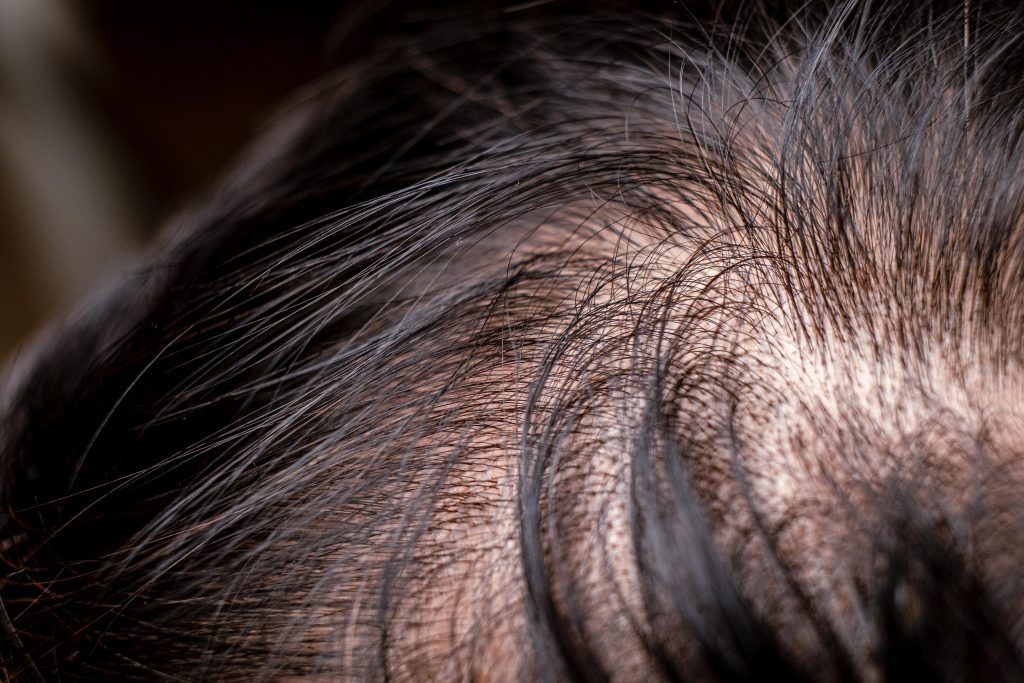
Androgenetic alopecia, more commonly known as male pattern hair loss or female pattern hair loss, is the most common type of hair loss and is hereditary. It affects more than 50 million men and 30 million women in the United States alone. The treatment for this type of hair loss is usually through medication or surgery.
Traction Alopecia is often a result of tight hairstyles that pull on the hair to the extent that it eventually damages and falls out of the hair shafts. Traction Alopecia can result in hair thinning and bald spots if it is consistently pulled on. The best way to cure this type of hair loss is by altering the hairstyles to loose up-dos that do not pull on the hair follicles. By doing so, it can encourage hair growth again.
Telogen Effluvium occurs when big numbers of hair follicles on the scalp are in the “resting” phase of the hair growth cycle without triggering the next phase of hair growth. This causes hair all over the scalp to fall without forming new hair.
Telogen effluvium is commonly a temporary condition that can be resolved as long as you can determine the cause. Some possible causes include intense stress, childbirth, rapid weight loss, thyroid disease and taking certain medications.
Anagen effluvium is when significant amounts of hair are shed in the anagen (growth) phase of the hair cycle. This is the opposite of telogen effluvium where hair fall is experienced during the resting stage of the hair cycle.
Anagen effluvium affects the scalp as well as all over the body. The causes of anagen effluvium include radiation therapy, fungal infections and chemotherapy.
This is a condition where the body’s immune system attacks the hair follicles. This causes a loss of hair on any part of the body from the scalp to inside the ears to the hairs on the toes.
Alopecia Areata is a polygenic disease which means it requires a pool of genes to be inherited from both parents to bring about the disease, as well as some contribution from the environment.
Tinea Capitis, also known as ringworm, is where fungal infections affect the scalp and hair shafts. Someone experiencing this condition would have an itchy scalp coupled with scaly and bald patches on their head. Sometimes, sores and blisters with pus can develop on the scalp as well.
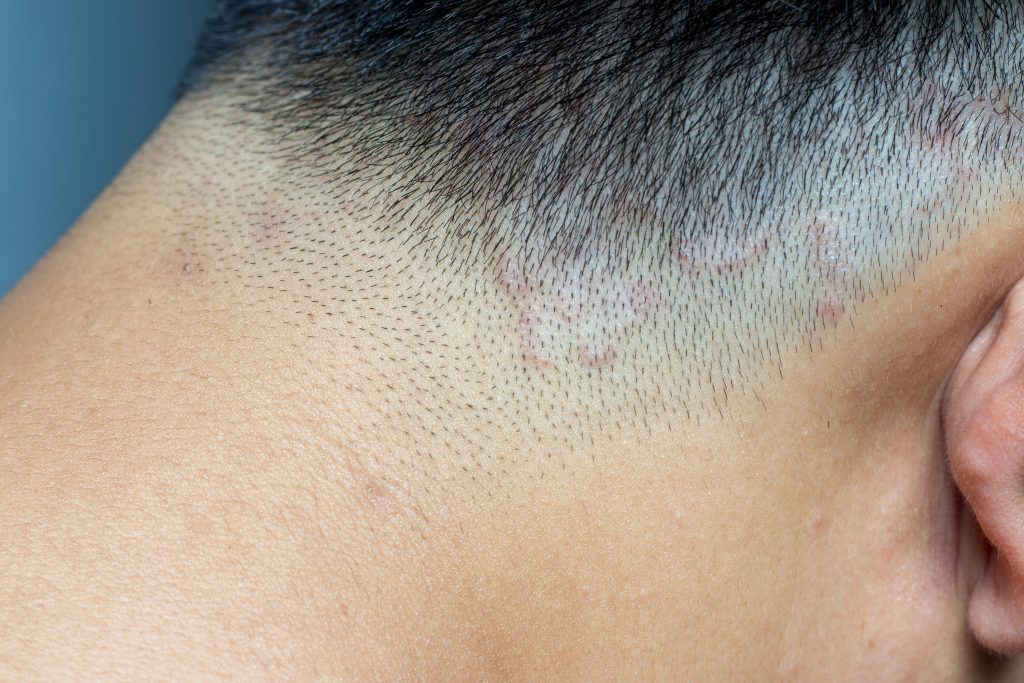
Tinea Capitis is more common in toddlers and children and is highly contagious. Treatment is often antifungal medications that can be consumed orally and have a prescribed shampoo for the period.
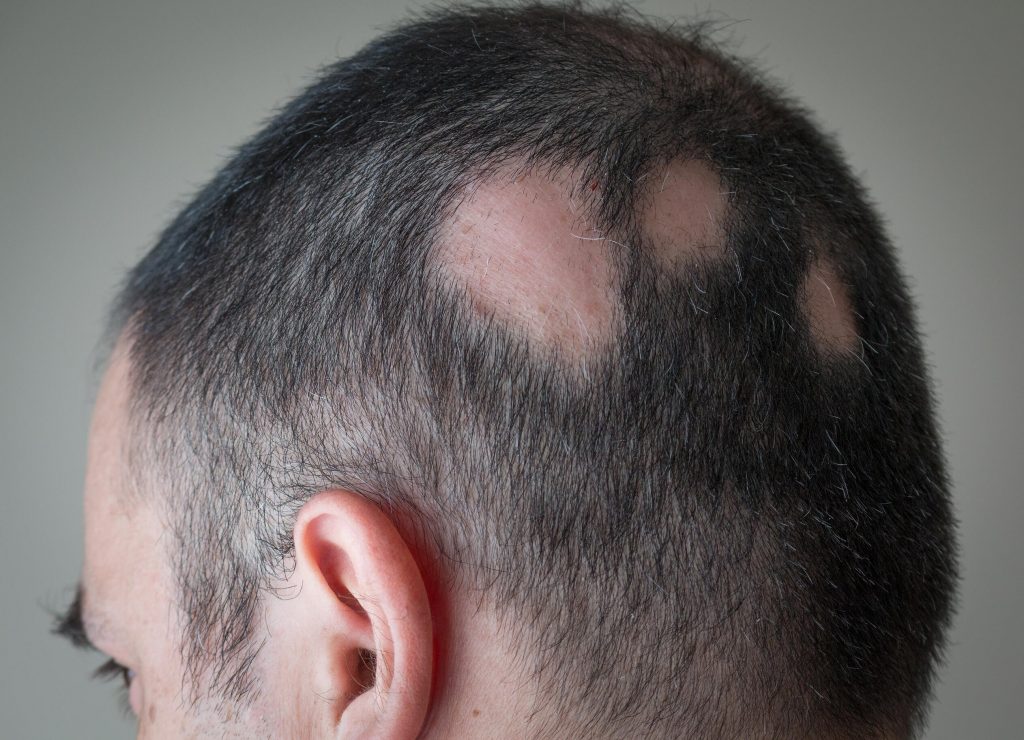
Cicatricial alopecia, also known as scarring alopecia, is a rare type of hair loss in which inflammation destroys hair follicles on the scalp and forms scar tissues in their place. Once the scar tissue forms, hair does not regrow in that area. There are many variations of Cicatricial Alopecia such as:
Lichen planopilaris happens when lichen planus affects the scalp. Lichen planopilaris causes dry, flaky rashes on the scalp which causes hair to drop off in handfuls. You can expect the scalp to be red, inflamed, and covered in small white or red itchy, painful bumps.
Lichen planopilaris is not a common condition and usually affects women more than men.
Discoid lupus erythematosus is a variation of cutaneous lupus, which is an autoimmune disease affecting the skin. With this condition, inflamed sores and scarring form on the ears, face, and scalp and hair loss is also one symptom. When the scar tissue forms on the scalp, hair can no longer grow on that area.
Folliculitis decalvans is an inflammatory disorder where hair follicles are destroyed. It is common to have redness, swelling, and pus-filled, itchy sores on the scalp. When the hair follicles are destroyed, it inevitably leads to hair loss. This type of hair loss is not reversible, but there are medications to aid with the damage control and sometimes, stop the hair loss.
Dissecting cellulitis of the scalp, also known as Hoffman disease, is a rare, chronic condition, where bumps, pustules and painful nodes develop on the scalp. You can also expect scar tissue to develop, destroying hair follicles, causing hair loss. The condition, if untreated, could evolve into scarring alopecia. You may be prescribed medications to help control the symptoms.
Frontal fibrosing alopecia is a patterned form of scarring hair loss that happens on the frontal scalp hair region. They typically result in receding hairline and may also cause hair loss in the eyebrows and underarms. Frontal fibrosing alopecia usually affects postmenopausal women. You may be prescribed medications to manage the symptoms of the disease.
Central centrifugal cicatricial alopecia is a variation of scarring alopecia on the scalp. More often than not, it is a result of using excessive hair products or styling techniques that damage hair follicles. As the hair follicles are destroyed, permanent hair loss is the main effect.
The condition can also be a result of the frequent use of oils, pomades or gel. Hair loss can be reversible if you stop using these hair products or styling techniques. You may be recommended to take medication to aid the hair to grow again.
According to The American Academy of Dermatology, it is normal to lose 50 to 100 hairs a day. This just means the hair is at the “resting stage” or telogen and they drop off to promote a new hair growth cycle. However, if you notice an abnormally high amount of hair fall, it is a cause for concern. Below are some symptoms of hair loss you may be experiencing.
This is the most common type of hair loss which affects people as they age. With age, men may notice their hairline starting to recede, exposing a larger forehead. Meanwhile, women typically experience having a broader hair part or a thinner ponytail.
Physical shock can also cause hair to drop. With gentle tugging, combing or washing your hair or even after, you may notice multiple strands of hair stuck on your hand or comb. This type of hair loss causes overall hair thinning but is usually temporary and can be cured.
You may also lose hair in circular or patchy spots on the scalp. This also happens to the beard and eyebrows. With this type of hair loss, the skin of your scalp often becomes itchy and painful before the hair falls out.
Scalp psoriasis is a common skin disorder involving inflamed, raised, scaly patches on the head. It can appear as a single patch or several on part of the scalp or even your entire scalp. The condition itself does not cause hair loss. However, constantly picking and scratching at affected areas and doing harsh treatments can lead to hair loss. Fortunately, the hair loss is temporary and your hair can grow back when the skin clears up.
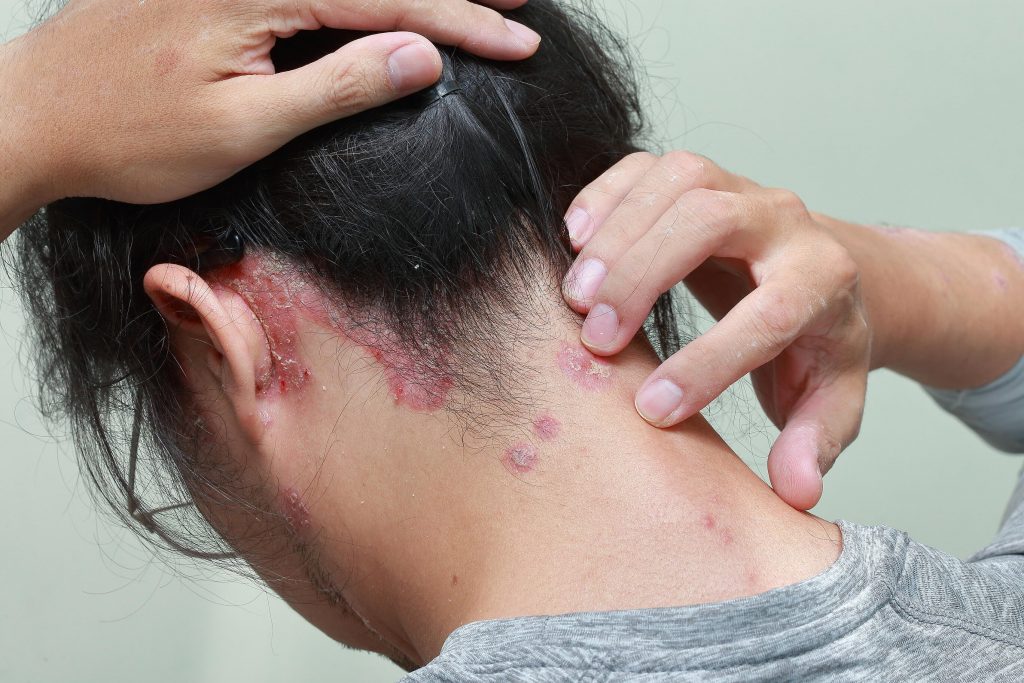
There is a myriad of reasons and risk factors your hair may be falling from environmental factors, diet, heredity and even treatments. Some common causes include diet, family history, pregnancy, stress, age, rapid changes in hormones, medication, sexually transmitted infection, scalp infection, radiation therapy, drastic weight loss, and certain medical conditions.
The most common cause of hair fall is genetics. Due to the genes, hair fall is common in both men and women and is prevalent in any age group. It cannot really be cured but it can be controlled with diet, certain hair products and changes in hairstyles. In this type of hair loss, you normally experience hair falling from your scalp but could also fall from other parts of your body. You can normally identify genetic hair loss with male pattern baldness or female pattern baldness.
Diet has a huge impact on the external features of the body. Collagen, which is a degenerated version of the protein, is known to make your skin, hair and nails stronger. This is because your hair is mostly made up of protein. Hence, if your diet doesn’t include much or enough protein, you can expect hair loss.
Unhealthy diets with excess consumption of sugar, fats and lifestyle choices such as binge drinking and smoking affect the quality of your hair as well. Sugar produces insulin and androgen, which shrinks hair follicles and forces the hair to fall out. Eating too many fried foods can cause testosterone levels to surge leading to a higher chance of developing male pattern baldness.
Vitamin and nutrient imbalances such as toxicity of vitamin A, B, E and an iron deficiency can affect hair loss as well.
Another phenomenon is known as crash diet also contributes to the cause. This is when you dramatically restrict your calorie intake. This means you likely are not consuming adequate essential nutrients such as proteins, zinc and fatty acids. These deficiencies, especially if maintained over time, can lead to a type of hair loss called telogen effluvium.

The good news is that the hair fall is irreversible. Once you are able to pinpoint what foods are causing excessive hair loss, you will see stronger hair and less hair fall once you regulate the consumption.
Some foods that are known to help reduce hair fall and promote hair growth include eggs, chicken, carrot, lentils, oats, walnuts, fish, tofu, broccoli, all kinds of greens. and yoghurt.
Pregnancy causes a change in hormones in women. After giving birth, women experience a decrease in the hormone, estrogen, in their body. This causes the hair follicles to go into the resting phase of the hair cycle, also known as telogen. With that, they start to experience hair fall more rapidly than they had before. The hair loss is not enough to create bald spots and it gradually improves 3 to 4 months post-delivery.
Stress is one of the most prevalent reasons for hair loss and is known as telogen effluvium. If you feel an extreme amount of stress, the hair follicles force themselves to go into the resting stage of the hair cycle where the hair falls without instigating more hair growth. If the stress persists, you can expect patchy bald spots on the scalp. There is no measurement of how much stress could cause hair loss as it is subjective to each individual. However, if your stress is managed and reduced, the good news is that hair grows back and restarts the anagen of the hair cycle once again.
A side effect of age is gradual hair loss which is almost always hereditary. By the time you turn 30, you have lost about 20% of the hair on your head from a healthy head. Men can expect to lose 50% of their hair by the time they reach the age of 50 and be well into noticing they have male pattern baldness. Women, on the other hand, would have noticed female pattern baldness by the time they turn 70 where they will start to see a wider hair parting. This is very normal and they shouldn’t need to worry about it.
Similar to pregnancy, women experience hair fall due to the rapid changes in hormones. With menopause, the levels of estrogen fall drastically which then cause hair to become finer (thinner) since hair follicles shrink. Hair grows more slowly and falls out more easily in these cases.

As ironic as it sounds, medication can sometimes lead to other adverse side effects. Most of the time, medications contribute to two types of hair loss: telogen effluvium and anagen effluvium. Some common medications include birth control pills, acne medications containing retinoids, antibiotics and antifungal drugs, antidepressants, steroids and mood stabilizers. They usually cause temporary hair loss, or at least while you are on these pills.
With STI and STDs such as chlamydia, the side effects may include temporary alopecia. If they are treated, the hair is able to grow back again. If left untreated, a sexually transmitted infection (STI) can lead to further, more serious hair loss. For instance, syphilis, if left untreated, can cause patchy hair loss on the scalp, eyebrows, beard, and elsewhere. Therefore, it is important to get yourself tested for sexual infections and diseases before the matter escalates.
There are few types of scalp infections that could lead to hair fall like ringworm (also known as Tinea Capitis), Folliculitis and Piedra. Most of these infections are caused by fungus taking over the scalp and hair follicles, disrupting the normal hair growth cycle and therefore leading to hair loss.
Radiation therapy is a treatment for cancer patients that uses high-beam rays like X-rays and protons to kill off cancer cells in the affected area.. Due to the exposure to radiation, hair is induced to fall. The process of hair fall usually starts 2-3 weeks after therapy has begun and typically leads to hair falling in chunks. Hair grows back after the treatment.

Drastic weight loss can cause hair fall. This is due to nutrient deficiencies or strict diets that limit receiving all the nutrients for the body to function well. Fluctuations in the bodyweight cause physical stress and signal the hair follicles to move into the telogen stage. Hair loss after weight loss is usually associated with Telogen Effluvium.
Certain medical conditions such as thyroid, diabetes and lupus can cause hair loss. With thyroid, due to hormonal changes, the hair growth cycle is affected, causing it to move into the telogen stage which leads to hair fall. Hence, it is crucial to get the right medications to put a pause to the condition without elevating it.
Once you are experiencing hair loss, it is important to investigate the causes and treat accordingly to prevent further hair loss. As you have read, hair loss has many different causes and therefore, needs different treatments. Some hair treatments include medication, specific hair products and if all else fails, professional intervention.
Early stages of hair loss can be treated with oral and topical medication and do not require surgical intervention. With some of the types of hair loss, the effect may even be reversible if certain hair products, styling tools or hairstyles are either changed or completely not used on the scalp anymore. Therefore, it is important to diagnose your hair loss properly and early via consultation with standard blood tests, pull tests, scalp biopsy and light microscopy.
There are oral and topical medications that specifically aim to reduce hair fall. Below are some instances:
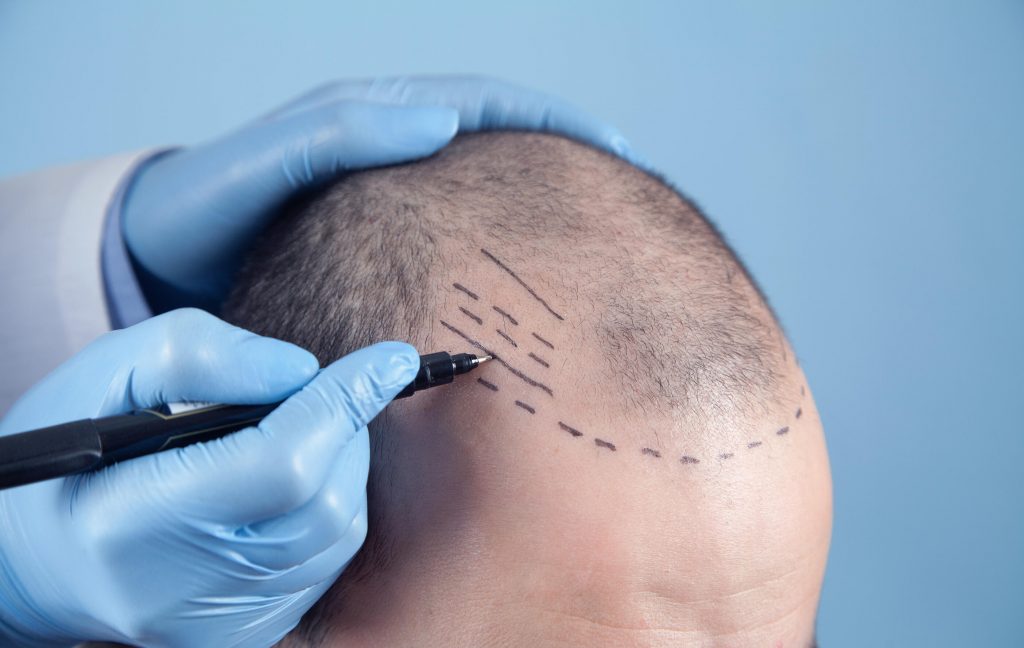
If medications do not work for you, a more surgical method to recover the hair loss you have been experiencing is through hair transplantation. The dermatologist will start by taking hair from areas that have a dense amount of hair and planting it at balding spots to encourage hair growth. This is useful for those experiencing male and female pattern baldness and receding hairline. Although this is a surgical procedure, not everyone is suitable for surgical intervention. You will have to seek medical advice and have a thorough assessment from a dermatologist to find out if you are eligible. Although the condition of your hair differs from individual to individual, generally, you need to have:
If you do not meet these requirements, you won’t be suitable for a hair transplant. At Nuffield Aesthetics, we offer hair transplantation services with 2 different types of technology – Regenena or FUE. Read all about these technologies here.
As you may have read above, there are many types of hair loss, with various symptoms, causes and treatments. Therefore, before proceeding with hair surgery, it is important to seek professional advice.
There are many types of home remedies you may be familiar with that aid with hair loss. While they may be effective for some, it depends on each individual’s condition. Some of the more common home remedies include:

As you can see, the causes, reasons and symptoms behind hair loss differ which mean the treatment for each type vary as well. To get a comprehensive assessment of your hair, scalp and hair loss, it is important to go to an experienced clinic that can advise you accordingly. At Nuffield Aesthetics, we believe in being honest and helpful to our patients to give them the best aesthetic advice for their wellbeing. A hair transplant is not suitable for everyone. However, if you wish to find out more, read here or book an appointment to speak to our aestheticians to find the best option for a healthy head of hair.
